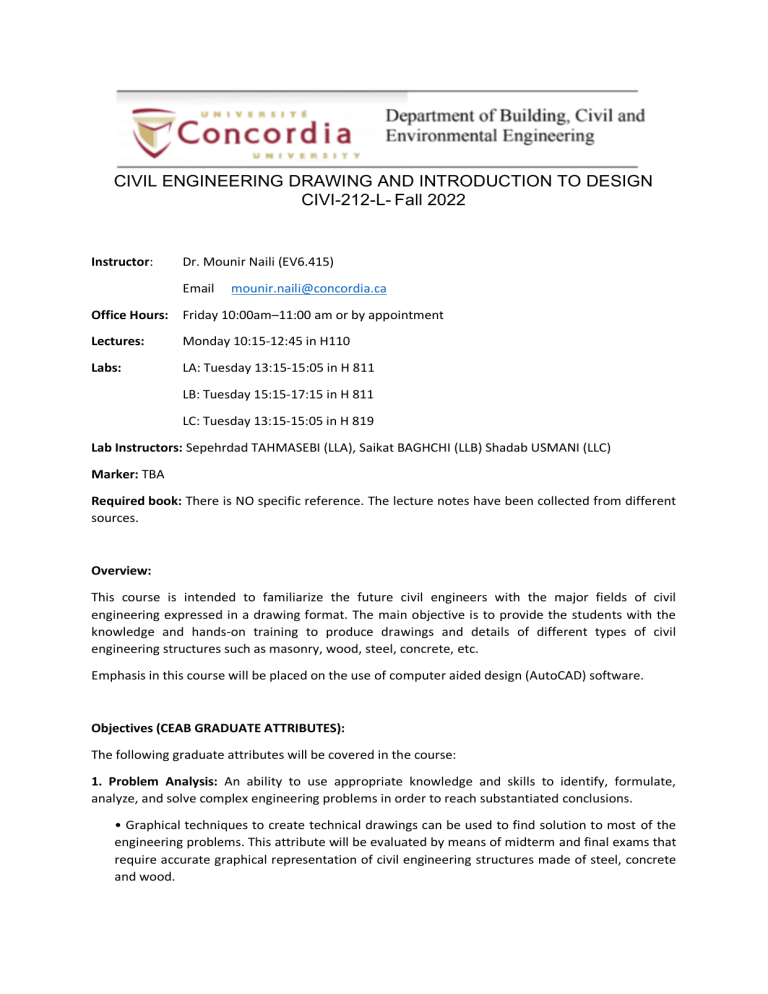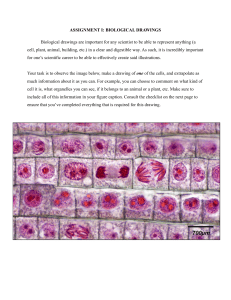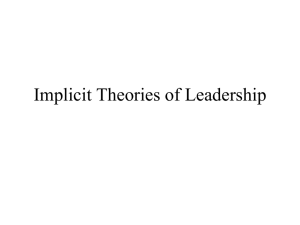Civil Engineering Drawing Course Syllabus - Concordia
advertisement

CIVIL ENGINEERING DRAWING AND INTRODUCTION TO DESIGN CIVI-212-L- Fall 2022 Instructor: Dr. Mounir Naili (EV6.415) Email mounir.naili@concordia.ca Office Hours: Friday 10:00am–11:00 am or by appointment Lectures: Monday 10:15-12:45 in H110 Labs: LA: Tuesday 13:15-15:05 in H 811 LB: Tuesday 15:15-17:15 in H 811 LC: Tuesday 13:15-15:05 in H 819 Lab Instructors: Sepehrdad TAHMASEBI (LLA), Saikat BAGHCHI (LLB) Shadab USMANI (LLC) Marker: TBA Required book: There is NO specific reference. The lecture notes have been collected from different sources. Overview: This course is intended to familiarize the future civil engineers with the major fields of civil engineering expressed in a drawing format. The main objective is to provide the students with the knowledge and hands-on training to produce drawings and details of different types of civil engineering structures such as masonry, wood, steel, concrete, etc. Emphasis in this course will be placed on the use of computer aided design (AutoCAD) software. Objectives (CEAB GRADUATE ATTRIBUTES): The following graduate attributes will be covered in the course: 1. Problem Analysis: An ability to use appropriate knowledge and skills to identify, formulate, analyze, and solve complex engineering problems in order to reach substantiated conclusions. • Graphical techniques to create technical drawings can be used to find solution to most of the engineering problems. This attribute will be evaluated by means of midterm and final exams that require accurate graphical representation of civil engineering structures made of steel, concrete and wood. 2. Design: An ability to design solutions for complex, open-ended engineering problems and to design systems, components or processes that meet specified needs with appropriate attention to health and safety risks, applicable standards, economic, environmental, cultural and societal considerations. • Assignments are provided to assess the ability to undertake simple design of a steel truss and a concrete column independently complying with drawing standards. 3. Communication: An ability to communicate complex engineering concepts within the profession and with society at large. Such abilities include reading, and listening, and the ability to comprehend and write effective reports and design documentation, and to give and effectively respond to clear instructions. • During tutorial sessions, students will be required to complete simple design tasks using AutoCAD under supervision of tutors to communicate engineering construction concepts and issues clearly and concisely. Individual reports in digital format are to be submitted following Canadian drawing standards. 4. Use of Engineering Tools: An ability to create, select, apply, adapt, and extend appropriate techniques, resources, and modern engineering tools to a range of engineering activities, from simple to complex, with an understanding of the associated limitations. • Students will be assessed by means of assignments for the uses of graphical design tools including hand drawings and AutoCAD tools to produce clear drawings and engineering sketches in traditional and electronic forms following applicable protocols and procedures when using tools. 5. Professionalism: An understanding of the roles and responsibilities of the professional engineer in society, especially the primary role of protection of the public and the public interest. • Final exam will be used to assess the development of students’ professional awareness in the role and responsibilities to be considered in civil engineering design. 6. Economics and Project management: An ability to appropriately incorporate economics and business practices including project, risk and change management into the practice of engineering, and to understand their limitations. • This attribute will be assessed by means of individual reports from tutorial sessions. Students are required to understand the needs and existence of different levels of engineering drawing details in project planning and implementation. Evaluation and Grading: 1) Assignments (4) 20% 2) Quizzes (2) 10% 3) Midterm 25% 4) Final Exam 45% Late submission will be accepted only with the prior approval of the instructor. A penalty of 10% per day late will be applied. Students must submit the assignments, and project with all relevant data and resource files, electronically. Lab participation is highly recommended. Those with attendance in less than 60% of the classes, and/or less than 50% score in the Exams will be assigned a failing grade. Tentative Schedule Week Date Topic Deliverable 1 Sept 12 Introduction Tutorials begin 2 Sept 19 Orthographic Projections 3 Sept 26 Multiview drawings 4 Oct 3 Provincial election (no class held) 5 Oct 10 Thanksgiving (university closed 5 Oct 12 Sectional Views 6 Oct 17 Isometric views 7 Oct 24 Auxiliary views 8 Oct 31 9 Nov 7 10 Nov 14 11 Nov 21 12 Nov 28 13 Dec 5 13 Dec 8 Assignment #1 Assignment #2 Midterm Introduction to AutoCAD Structural Systems Bearing walls type. Skeleton type. Applications to Civil Engineering project; Construction materials Concrete Structures Working drawing of standard steel sections, builtup sections, trusses, girders, Application to buildings and bridges Steel Structures Working drawing of standard steel sections, builtup sections, trusses, girders, Application to buildings and bridges Wood Structures Working drawing of roofs, slabs, beams, bearing walls, openings. Application to residential houses Masonry Structures Working drawing of bearing and retaining wall structures; Application to bridges Assignment #3 Assignment #4




